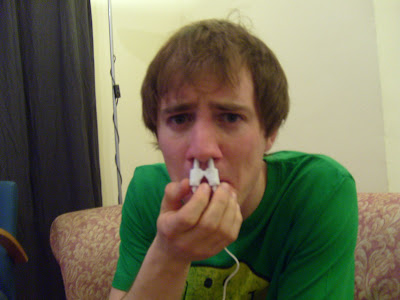

Histamine - the cause of our collective misery
Histamine is an important chemical in our bodies. It regulates sleep to some degree (which is why when you take antihistamines the boxes always warns you not to use heavy machinery afterwards - there's a small chance you could fall asleep) and has been shown to be released during sex too. Great.
Unfortuantely for us snivellers, it has a much more obvious role which is to act as an inflammatory agent. In principle this is good as when something horrid gets into our bodies we generally need to have our noses run (so that all the bad stuff, er, flows out) and our blood vessels inflammed (so that more blood carrying bug-eating cells get to the danger zone).
It's just a shame for me and my fellow sufferers that our bodies have declared war on ice creams in the park, wimbledon, a sunday afternoon stroll by the river and genereally anything else that involes being vaguely near grass during the summer months.
Since I was a boy I have been dosed up to the eyeballs from the end of April 'til arond September with prescription antihistamine medicines. I then switched Pfizer's expensive wonder cure Benadryl (mainly captivated by the adverts involving SWAT teams in helicopters swooping to the rescue of an atishooing sufferer). I've now cottoned on that a cheap antihistamine plus some decongestants will get rid of most of my symptoms. This does still add up however.
I've now received in the post what I dub 'the hayfever machine' which claims to be able to relieve the horrors of this condition using nothing more than a red light bulb. Of course there is the slight issue that in order to use it you have to sacrifice any iota of cool you may have (in my situation as a PhD Chemist this is more or less irrelevant, but still there is a duty to report, I feel) and cram two bulb-encasing prongs into your nostrils. These two prongs have red LEDs on their ends. You sit, uncomfortably, for three minutes, up to four times a day with these fellows in your nose and the light pouring in. The manufacturers claim it's 'safe, quick and easy to use and some sufferers will notice an improvement after just a few treatments'.

I sacrifice my last iota of 'cool'
Is there any evidence that this contraption works? One study I peroused (1) stated that after following the recommended course of treatment with the machine 72% of subjects felt their symptoms had been reduced and the study coordinators even went to the lengths of conducting an endoscopy (that is, sticking a miniture camera up the patients noses) and managed to confirm pictorially that this was the case for 70% of them.
How does this treatment work? In two ways apparently and by emmitting light of two different wavelengths. One wavelength of around 635 nanometers interacts with a light-absorbing chromophore (see article on Rhodopsin) in the white blood cells which causes a complex biological cascade of reactions which have been found to stabilise the cells and reduce histamine release. The second wavelength induces a dilation of nasal blood vessels which helps bring our bodies back to their resting state (2, 3).
I'll be reporting my degree of hayfever-induced misery on benchtwentyone as I begin using the device and we'll soon see if there's any truth in these claims.
Roll on summer.
References
(1) I. Neuman and Y. Finkelstein, Narrow-band red light phototherapy in perrenial allergic rhinits and nasal polyposis, Ann. Allergy Asthma Immunol., April 1997, 78, (4), 399 - 406.
(2) E. N. Goncharenko et. al., Bull. Exp. Bio. Medicine, effect of middle wave ultra violet and red light on degranulation peritonial mast cells in rats, 2006, 129, (4), 357 - 358.
(3) http://www.lazrpulsr.com/files/How_does_light_therapy_work.htm





1 comment:
I sincerely hope your suffering is reduced one way or another!
Very funny article.
love
Aud x
Post a Comment